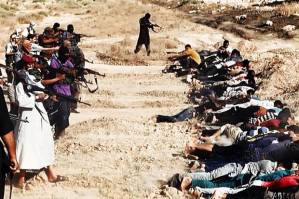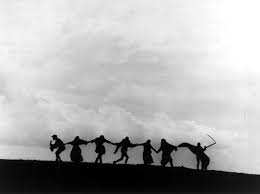For some time, I have been convinced that ISIS is tapping in to Western fears, using an intimate knowledge of our history, art and myth to stir night terrors for an entire civilization.
 This first occurred to me when I saw this picture, which I and many compared to the einsatzgrupen on the Eastern Front. The helpless victims with their backs to death, the collective nature of the method of of executions so all the killer share equally in the act tie the two scenes together across time.
This first occurred to me when I saw this picture, which I and many compared to the einsatzgrupen on the Eastern Front. The helpless victims with their backs to death, the collective nature of the method of of executions so all the killer share equally in the act tie the two scenes together across time.
 Contrast this to Goya’s rendering of a similar scene. The Spaniards in this painting will all surely die, but they face their killers and defy them. They have not been robbed of all agency. They die, but we know others will live. Beyond the horror is hope. It is if Goya could look across more than a century and see liberty arise from a sea of corpses. Whereas, the equally iconic picture of the the German killers presents no hope, only hopelessness, and shame at that helplessness. We have long thought -or hoped – that Goya’s was, in the end, the clearer vision.
Contrast this to Goya’s rendering of a similar scene. The Spaniards in this painting will all surely die, but they face their killers and defy them. They have not been robbed of all agency. They die, but we know others will live. Beyond the horror is hope. It is if Goya could look across more than a century and see liberty arise from a sea of corpses. Whereas, the equally iconic picture of the the German killers presents no hope, only hopelessness, and shame at that helplessness. We have long thought -or hoped – that Goya’s was, in the end, the clearer vision.

“Third of May” Francisco Goya. Napoleon’s troops shoot civilians. An archetype for countless atrocities over the next century and a half.
ISIS has been described as “sophisticated” in their media output, but the latest from Libya, is in my view, brilliant. Lets have a look at this still from the video of the mass murder of 21 Copts on a Libya shore.

21 Copts murdered. New reports of 21 captives held in cages. A reference to a 21 gun salute? I wouldn’t put it past this bunch.
First we see a line of obviously cowed, despairing men in orange jumpsuits, each escorted by a masked figure who towers above his captive. The use of orange jump suits in beheading videos goes back to at least Nick Berg, and is in part a riposte for the humiliations visited to some prisoners in Abu Ghraib. Beyond that, it is a mockery of our Western notions of justice. Unlike western prisoners, like those you sometimes see out clearing verges along highways, these men will have no lawyers, no work release, no parole. Only death. And this is as decreed in a multitude of Islamic sources. Allah’s law prevails, and the statutes of Pharaoh, Caesar and Parliament are as nothing. Note how the line recedes form the foreground into the distance. No matter how many “Crusaders” there are, there is a limitless supply of executioners. The setting along the shore is no accident. The shore in question is the southern Mediterranean, a Latin term meaning at the center of the earth, the sea that bound the Roman world together, Mare Nostrum, Our Sea. A sea that Islam cleft in twain for more than a millennium. This is to let us know that the sea is ours no longer, and will once again be theirs.
A shore is the limit of the human inhabited earth, a dead end. There are no waiting ships, and no escape. Only a brooding sky over an iron sea. A storm is coming.
 It is the back cloaked figures who tap most deeply in to our subconscious. The axeman is a familiar archetype. For how many centuries did Europeans live under rulers who could at a whim, send their subjects to the block, where a masked man in black would send them to eternity? In fact, beheading was reserved for the nobility, while the common man was more likely to go via the rope. Certainly, the hangman’s noose, remains a symbol of death, while the hangman is remembered in folklore, but who we see in our nightmares, is the axeman, perhaps because he figured in the last moments of so many famous historical figures. ISIS and others use knives, not axes. This is the tool of halal slaughter, a clear message that the victims are as beasts.
It is the back cloaked figures who tap most deeply in to our subconscious. The axeman is a familiar archetype. For how many centuries did Europeans live under rulers who could at a whim, send their subjects to the block, where a masked man in black would send them to eternity? In fact, beheading was reserved for the nobility, while the common man was more likely to go via the rope. Certainly, the hangman’s noose, remains a symbol of death, while the hangman is remembered in folklore, but who we see in our nightmares, is the axeman, perhaps because he figured in the last moments of so many famous historical figures. ISIS and others use knives, not axes. This is the tool of halal slaughter, a clear message that the victims are as beasts.
In this painting of the execution of Lady Jane Gray one sees a similar sort of obscene intimacy as that in the lSIS Libyan video, where the executioners each guide their victims with a hand on the shoulder. They proceed in step, both part of the choreography.( Surely this was rehearsed.) While I’m not a cinematography nerd, as a long time consumer of horror movies, the technique in the ISIS short seems familiar. There are a couple of tricks I’m sure I’ve seen in the kind of second tier scare flicks you see on Thirll TV.
Open on an empty beach. Which quickly rushes up to the viewer, then back again, a kind of whiplash view accompanied by reptilian chattering. Same again, but the line of men is now on the beach. Again, and the beach is empty. Then the men return and the narrative becomes more conventional There is a declaration, the usual tale of victimization and retributive aggression.
The camera lingers briefly over each face that we will remember them. When the moment comes, the men are shoved on to the sand in a wave action beginning at the far end of the line. Continuity disappears. There is a brief montage of violence, blood, body parts ,screams and exultant shouts. I have seen this before. The violence is such that we comprehend its nature, but so brief that a gag reflex isn’t triggered. The dialogue may well sound better in Arabic and perhaps a more competent translator might have given it greater power. Nevertheless, it bares examination as some of it has been much in the news.
The beheaded Copts are referred to as Crusaders, which may be read as any Christian in Muslim lands. In this instance,and many others, pundits have referred to the enduring wounds of the Crusades, which is utterly nonsensical. Islam won the Crusades and they were of little import until anti-Catholic historians made much of them and their victimization of idealism Islamic societies, beginning with Edward Gibbon. Another Edward, Edward Said, was notable among many others in the last century who recast the Crusades as the first assault of Western Colonialism upon non-Western peoples.
Equally laughable is the speculation of some that the Jihadi pointing his knife towards Rome is an attempt to enlist Libyan nationalists resentful of Italian domination. The Italians have been gone from Libya since Montgomery kicked them out in 1943. Indeed, the knife wielder makes a point of his geographic proximity to today’s Rome, but Islam has a long history with both the city,and the idea of Rome. Islam arose in th 7th Century decades after the official end of the Western empire, but the City of Constantine, the New Rome, endured until 1453. Beyond, the city, Rum, the polity, and Rumi, the people were for Islam the entire West.
The speaker says that they will take Rome, and Jesus will return to “overthrow the cross.” This demented eschatology is orthodox in Islam. In 1984, Orwell` posited an end to history in which a boot stamped a human face, forever. With Islam, it is a knife to a human neck.
This short film thus uses Western mass communication techniques to at once feed on our ancient terrors and to rally Islam to an interrupted conquest, with the aid of anti-colonial Marxist derived tropes perpetuated by the West itself.
Brilliant.
Koran 3.151
Soon shall We cast terror into the hearts of the Unbelievers, for that they joined companions with Allah, for which He had sent no authority: their abode will be the Fire: And evil is the home of the wrong-doers!



Just for fun, forward the to the spectator. It really is THAT good
Thanks! Spectator? The one in UK?